National Weather Service Cuts: Implications for Public Safety and Preparedness
- edu.plus.weatherray Rome
- Jul 30
- 3 min read
Recent budget cuts to the National Weather Service (NWS) have sparked serious concerns about public safety. With the rise in extreme weather events, these cuts could have lasting effects on how communities prepare and respond. Understanding the specifics of these changes is crucial as we navigate a future that will likely be weather-challenged.
Understanding the Budget Cuts
The NWS has faced budget cuts as part of a government-wide effort to tighten spending. In recent years, funding for the NWS has been reduced by approximately 10%, leading to decreased resources for both staffing and technology. This reduction endangers the service's ability to provide weather predictions and alerts that people depend on for their safety.
The service requires funding for forecasting models, radar systems, and the personnel to run these operations smoothly. As funding shrinks, so does the capacity for effective weather monitoring and emergency response.
Consequences for Forecast Accuracy
Accurate weather forecasts are vital for public safety. For example, during a hurricane, timely alerts can save lives by allowing communities to evacuate or secure structures in time. Without sufficient funding, the quality of forecasting could decline sharply.
With cuts, the NWS may not be able to hire enough meteorologists or invest in advanced technology. In a 2018 study, it was found that a 20% reduction in meteorologist staffing could lead to a 30% increase in missed severe weather alerts, putting individuals and families at risk during critical moments.
Impact on Community Preparedness
Preparedness relies heavily on accurate weather information. During emergencies, local services look to the NWS for updates to coordinate their responses. However, if forecast accuracy diminishes, communities may find themselves unprepared for floods, tornadoes, and other disasters.
For instance, if a tornado warning is delayed or inaccurate, a community might not have enough time to implement its emergency plans. The risk extends beyond individual safety; entire neighborhoods or cities may be caught off guard.
Importance of Accuracy in Weather Warnings
Clear weather warnings are crucial in protecting lives. Individuals must understand potential dangers to act swiftly—whether that means seeking shelter or evacuating entirely. Inaccurate or delayed warnings can have dire consequences. In 2020 alone, the U.S. faced 385 weather-related fatalities, many of which stemmed from inadequate communication.
The need for precise and timely forecasts from the NWS is more apparent than ever.

Community Action and Response
With NWS cuts, it's critical for communities to enhance their preparedness efforts. Relying solely on national resources may no longer be enough.
Community members can start by creating emergency plans that include:
Emergency kits stocked with essentials like food, water, and first aid supplies.
Regularly updated communication channels. Following local news and weather apps can provide timely information.
Grassroots efforts can foster resilience, helping communities better brace for adverse weather events despite reduced federal support.
The Role of Technology
Advancements in technology offer personal alternatives for staying informed. Many smartphone apps and weather alert systems can provide real-time updates, acting as a valuable supplement to traditional NWS services. For instance, apps like the NOAA Weather Radar Live can offer alerts based on location, ensuring that individuals stay informed.
While these resources cannot fully replace the expertise of the NWS, they can help communities fill the gaps caused by budget cuts.
The Bigger Picture
The fallout from budget cuts goes beyond immediate weather services. It raises questions about resource allocation amid climate challenges. As extreme weather becomes more frequent, it is crucial for the government to prioritize funding for the NWS and similar services.
Investing in weather preparedness now could save countless lives in the future. Communities need to advocate for proper funding to ensure their safety.
Education and Awareness
Educating the public about the NWS's challenges can motivate community involvement. By hosting informational sessions and workshops, individuals can learn the importance of accurate forecasting and how to prepare for severe weather.
These initiatives can cover topics like understanding weather patterns and responding to alerts. Knowledge is a powerful tool for enhancing community resilience.
Final Thoughts
Budget cuts to the National Weather Service are a serious issue that can undermine public safety and preparedness. It is crucial for everyone to recognize the risks and take proactive steps to ensure their safety.
By embracing personal responsibility, utilizing technology, and advocating for adequate funding for weather services, communities can work together to offset the negative impacts of these cuts. As weather events grow more unpredictable, the need for reliable forecasting remains a top priority for safeguarding lives and enhancing preparedness.

Collective efforts will be essential. The better informed we are, the more equipped we will be to face the realities of our changing climate.




Comments